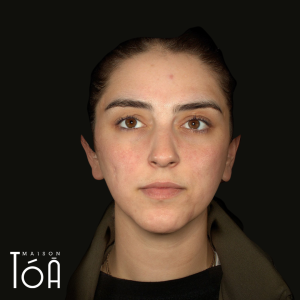Acne treatment
Acne treatment is performed in our clinic based in Lausanne. Acne is a dermatosis or skin condition that develops at the root of the hair, usually on the face. This proliferation of acne pimples can be mild or severe, it usually begins at the age of puberty with hormonal development and can, sometimes, extend into the 40s.




What is this acne?
The skin will produce, through its multiple pilosebaceous follicles, sebum on the surface of the skin, thus creating a lipidic film important for skin protection against external aggressions (pollution…).
During hormonal acne, the pilosebaceous follicle is responsible for an excessive production of sebum under hormonal hyperstimulation. The pores will then become clogged and obstructed. This causes the appearance of comedones (blackheads) and white microcysts. This is called retentional acne. A bacterial proliferation may also appear inside these comedones and microcysts, which is responsible for the second form of acne: inflammatory acne.
Inflammatory acne is characterized by the appearance of small red spots, pustules and cysts. Cysts are nodules under the skin that contain pus. Unlike pimples, cysts do not reach the top of the skin and therefore remain inside the skin responsible for the main acne scars.
If acne is visible on the face, it can also appear on the neck, back, chest and torso.
Why can one be subject to acne ?
Hormonal secretion is the cause of the vast majority of acne. At puberty, both boys and girls produce an abundance of certain hormones (testosterone and androgens). These hormones are released into their bodies. Androgens affect and act on the sebaceous glands by producing more sebum. This increased sebum secretion clogs the pores of the skin. Clogged pores and certain bacteria in the skin lead to blackheads, cysts and pimples.
Boys have more testosterone than girls and may experience more acne breakouts during puberty. For girls, the acne condition may appear earlier than for boys. They may also have breakouts at different times during their menstrual cycle and are more likely to have acne into adulthood due to persistent hormonal variation.
It should be noted that poor dietary habits, smoking, pollution, stress and make-up are not responsible for acne on their own, but they are triggers due to their actions on the body’s inflammatory system. It is therefore recommended to limit these different factors as much as possible during an acne outbreak.
Our clinic specialized in acne treatment based in Lausanne, Switzerland, can answer all your questions on this subject.
What medical treatment can I consider?
To treat acne effectively, several solutions are possible.
During a medical consultation, your dermatologist will prescribe soaps, creams or anti-acne medications, depending on the form and severity of your acne. The most common ones are:
To treat acne effectively, several solutions are possible.
Benzolyl peroxide soaps or gels for their anti-inflammatory properties, but also for their ability to reduce the production of sebum and decrease the production of the bacteria that cause acne.
Retinoids, which are derivatives of vitamin A, accelerate skin renewal and unclog clogged pores. They also prevent the appearance of new skin obstructions and, over time, improve imperfections such as acne scars. They are prescribed as creams for mild or moderate acne and orally for severe acne.
Antibiotics that reduce inflammation and kill the bacteria that are mainly responsible for red spots.
The contraceptive pill, which reduces the levels of androgens and sebum in the body.
Laser
CO2 laser for the treatment of scars and post-acne spots
The fractional CO2 laser works by heating the surface of the skin. It crosses the epidermis through multiple microperforations, into the middle to deep dermis, for a global regeneration of the different layers of the skin. As the skin heals, these wells will close and lead to skin resurfacing which, in several sessions, will considerably reduce scars and post-acne spots. Learn more about CO2 laser treatment
LED
Light therapy to treat acne
Acne treatment with blue and red light is a completely natural and painless treatment that can be performed on all skin types.
The first results are usually visible after the second session. The once-a-week treatment lasts an average of two months, followed by a once-a-month treatment until the acne disappears. Discover light therapy, one of our clinic’s specialties.
Tóā Signature treatments
Fruit acid peel and blackhead removal to treat acne
This treatment combines the exfoliating power of fruit acids with the manual extraction of your blackheads by our expert esthetician. Elimination of impurities: sebum, dead skin, blackheads guaranteed.
The Signature Radiance Treatment can be performed as often as needed.
Microneedling
Microneedling for the treatment of scars
Microneedling is a minimally invasive procedure that uses a pen containing microneedles to make microperforations in the different layers of the dermis. The micro perforations will then let penetrate active principles regenerating the epidermis, while stimulating the formation of its collagen. This treatment aims to improve skin quality and overall complexion by smoothing irregularities such as acne scars.
Discover the microneedling treatment.
All about acne:
Let’s just say that living with acne is certainly not easy. Unfortunately, for those who finally get rid of it, the problems remain in the form of acne marks and scars on the skin. And in the most severe cases, i.e. in the presence of severe acne, the scars can leave real little craters in the skin.
Acne vulgaris, commonly known as acne, is a common, non-contagious skin condition that involves inflammation and infection of the sebaceous glands. It usually develops during puberty, with hormonal changes, and can persist into adulthood. It is generally distinguished according to its “severity”, subdivided into acne:
- Mild (Acne Comedonica)
- Moderate (Acne papulo-pustular)
- Severe (Acne Conglobata)
Statistically speaking, acne and more generally skin impurity problems mainly affect teenagers, but more and more adults, especially women (who can present the first symptoms even after the age of 25) suffer from this dermatological condition.
Persistent acne or acne that develops in adulthood is also known as late acne. The parts of the body usually affected are
-
- Face
- Neck
- Shoulders
- Chest
- Back
Acne is not only a skin condition, but it often affects people’s quality of life and how they perceive themselves. This is why physical discomfort is often accompanied by self-esteem issues.
Before we answer the question we asked at the beginning of our article, “What is the best way to get rid of acne scars?”, it is worth understanding what causes impurities. According to some erroneous myths, acne and skin impurities are related to poor hygiene. This is not true.
What are they? We list below the most known of them.
Genetic factors
This is certainly the first factor to consider. It’s no secret that genes determine our skin type. And that means that some people are more prone to inflammation, blemishes and acne breakouts than others.
Often, for example, if both parents have suffered from this condition, there is a high probability that their children will also suffer.
Hormonal Factors
As mentioned earlier, acne is closely linked to hormonal changes. Hormones are responsible for stimulating the formation of sebum produced by the sebaceous glands. They are present on the entire surface of the body, except for the palms of the hands and soles of the feet. Excessive sebum production is unfortunately one of the factors that characterize impure skin.
During adolescence, increased hormones often lead to acne. As in adulthood, hormonal changes related to the menstrual cycle are one reason why the problem worsens in women.
Taking medication
Yes, taking certain medications also promotes the development of acne. We are referring to steroids and lithium in particular.
Nutrition
Although not considered the cause of acne breakouts, a correlation between acne and what you eat has been established.
An example? A diet with a high glycemic index and eating a lot of dairy products can make acne worse.
Stress and smoking
Like a chain reaction, stress is capable of stimulating hormones that, in turn, promote the production of sebum that leads to acne breakouts.
Similarly, smoking, according to some studies, can also exacerbate acne, being a cause of oxidative stress and sebum alteration.
The answer is simple. They form when the outermost layer of the skin is damaged and the deeper layers are also affected.
When the skin fails to regenerate properly, the wound is covered with a granular tissue made of collagen fibers. This “regenerated” tissue heals the wound, although it may still be visible.
The most common acne scars are
- Atrophic: pitted and deep. They appear when a wound does not heal optimally and there is little connective tissue.
- Hypertrophic: raised on the skin. Inflamed skin produces an “underlying” tissue that is not structurally the same as healthy tissue and is actually thicker and more visible.
- Keloids: raised and red/purple in color. They form due to the expansion of the hypertrophic scar into other areas of the skin. However, this scarring is only occasionally caused strictly by acne.
Finally, we answer our question: how can I get rid of acne scars?
Let’s start with prevention. This means preventing the formation of scars. And for this, it is enough not to crush or abuse, with your fingers or other instruments, the black or white spots and other impurities of the body.
And if this is not enough and scars have formed?
There are several treatments depending on the type of scarring.
For pigmented scars, the most effective solution is a peel!
It is an aesthetic treatment which, thanks to the application of exfoliating products, allows the removal of dead cells and their regeneration.
It is ideal to fight against :
-
- Aging of the skin
- Dyschromia
- Skin blemishes
- Acne in active phase
- Hyperseborrhea
- Dull, matte skin
The peeling is applied by means of a deep massage that follows the elastic tension lines of the tissues. Among the substances used to perform the treatments are salicylic acid, which has great exfoliating properties and is ideal for treating blemishes and thickening of the skin, and pyruvic acid. The latter, in particular, has sebum-regulating properties and helps to unclog pores occupied by blackheads.
For atrophic scars, we can use either medical microneedling or the CO2 laser. In both techniques small holes are made in the skin into the dermis in order to regenerate the skin where the scarring has occurred.
The CO2 laser will allow to go in depth, so it is recommended to patients with severe scars while the microneedling, lighter for more superficial scars.
Intervention
-
Objective
Reduction of acne pimples
-
Technique
Cream – Medicine – Laser – LED – Peeling
-
Price
1st medical consultation reimbursed by the basic insurance
– LED : from Fr. 150.00
– CO2 laser from Fr. 500.00
– Microneedling : from Fr. 300.00
– Peeling : Fr. 250.00 -
Result
Clean and purified skin
